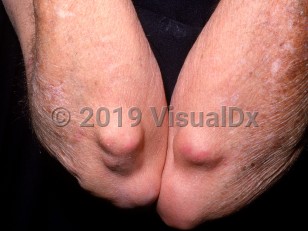Rheumatoid nodule in Child
Alerts and Notices
Important News & Links
Synopsis

Patients affected with rheumatoid nodules will often have a high titer of rheumatoid factor. In addition, patients with RA who are positive for rheumatoid factor and anti-cyclic citrullinated peptide (CCP) antibodies are more likely to develop rheumatoid nodules. However, patients with mild RA may also develop rheumatoid nodules, as may patients who have rheumatoid disease without significant joint involvement. Nodules can also precede the onset of clinically significant arthritis by a number of years.
Rheumatoid nodules may persist, enlarge, or spontaneously regress over time. Nodules on areas subject to pressure or trauma, such as the sacrum, have a greater tendency to ulcerate. Secondary infections of ulcerated rheumatoid nodules can lead to septic arthritis. Additional complications of rheumatoid nodules include pain, reduced joint mobility, and peripheral neuropathy.
In a poorly understood phenomenon, patients with RA treated with methotrexate and TNF-alpha inhibitors can experience an increase in the number and size of rheumatoid nodules.
Codes
M06.30 – Rheumatoid nodule, unspecified site
SNOMEDCT:
33719002 – Rheumatoid nodule
Look For
Subscription Required
Diagnostic Pearls
Subscription Required
Differential Diagnosis & Pitfalls

Subscription Required
Best Tests
Subscription Required
Management Pearls
Subscription Required
Therapy
Subscription Required
Drug Reaction Data
Subscription Required
References
Subscription Required
Last Updated:02/28/2019

